#オーガニック #無農薬 #自給自足 #スローライフ #家庭菜園 #ゴーヤ #bittergourd #苦瓜 #にがうり
Harvesting
- ゴーヤの収穫【Harvesting bitter gourd】
- ゴーヤ/Bitter gourd について
- ゴーヤの種類
- ゴーヤの育て方
- 最近は北海道でもゴーヤ(ニガウリ)の露地栽培が可能に(地球温暖化の影響が心配)
- ゴーヤの独特な苦味と食感を活かした、様々な料理の例
- ゴーヤの収穫時の「見落とし」完熟・種子爆発という現象について
- まとめ
- 農産物の加工
- トマトソースづくり
- オーガニック栽培(無農薬栽培)の現実
- 【スローライフ】 まとめ
- 家庭菜園メリット
- ハロウィンかぼちゃ
- 収穫はこれがあると便利!
- フレッシュトマトジュース作りにはこれが便利(我が家も利用)Kuvings クビンス
- 家庭菜園(ガーデニング)
- おすすめ本
- 北の大地十勝(北海道)に移住
ゴーヤの収穫【Harvesting bitter gourd】
ゴーヤ(苦瓜)の収穫
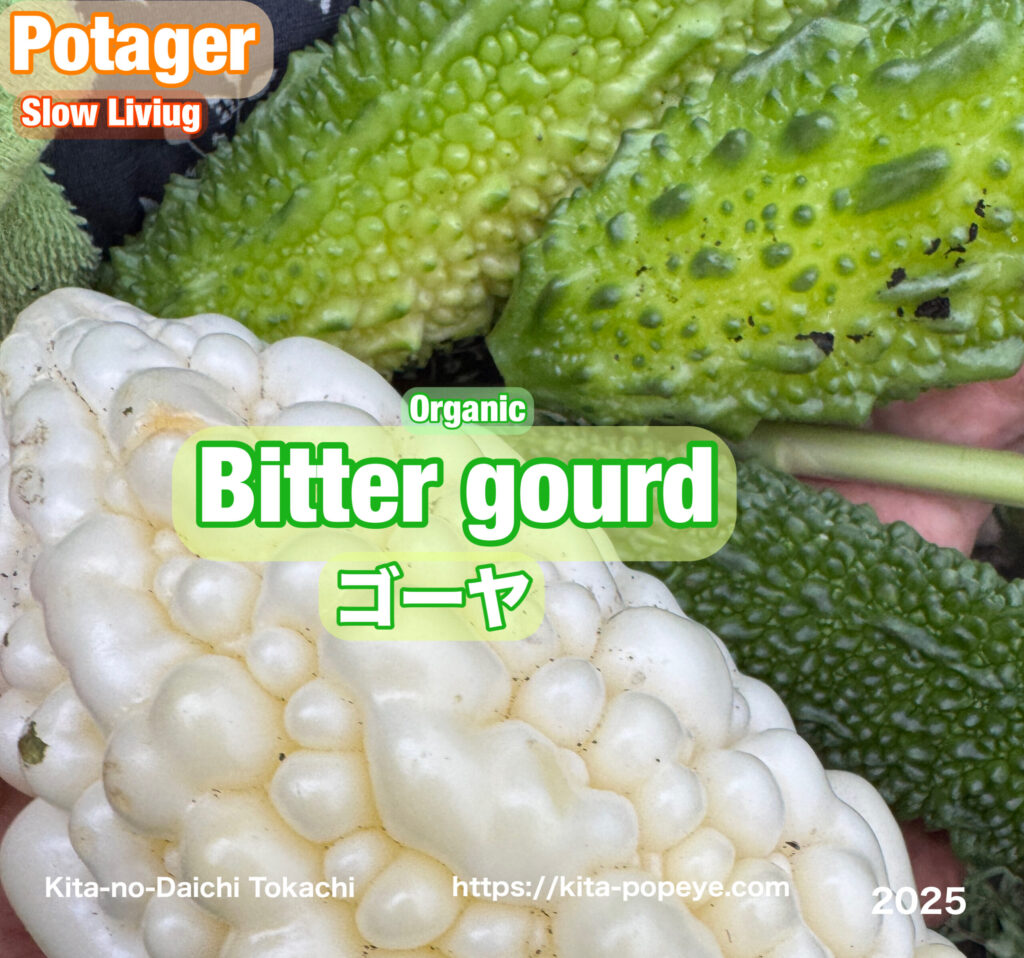
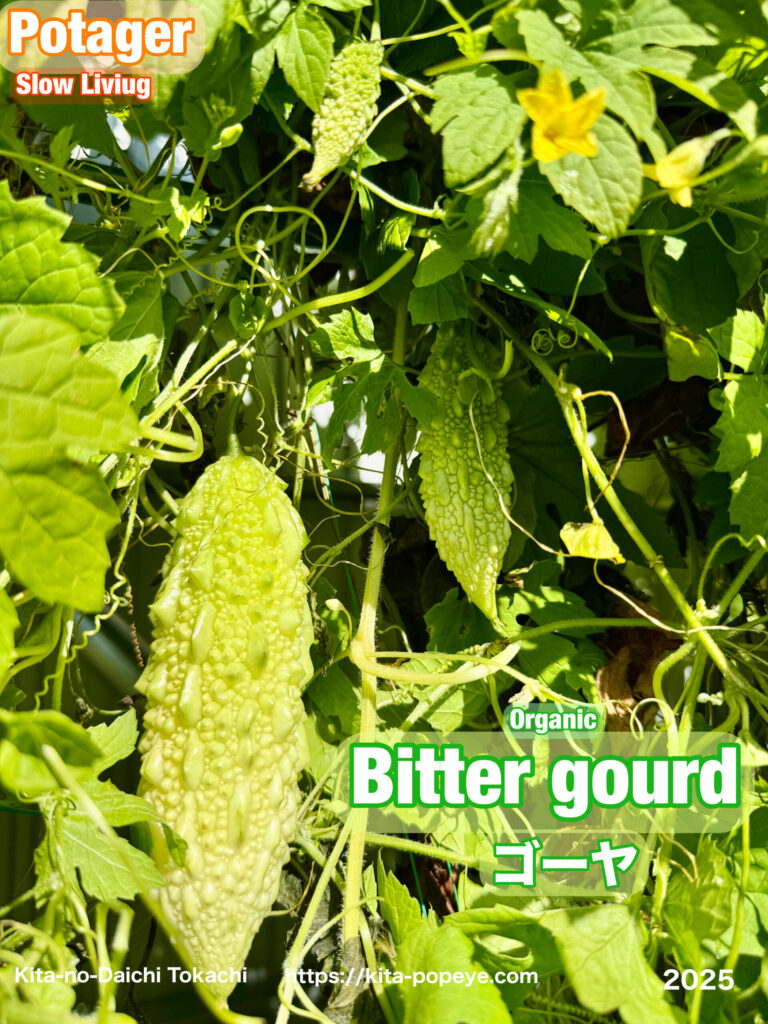
ゴーヤ/Bitter gourd について
日本語 (Japanese)
• 名称
• 一般的に「ゴーヤ」または「ゴーヤー」と呼ばれます。これは沖縄の方言に由来しています。
• 和名は「ツルレイシ(蔓茘枝)」です。
• 別名で「ニガウリ(苦瓜)」とも呼ばれます。
• 特徴
• ウリ科のつる性植物で、熱帯アジア原産です。
• 主に未熟な緑色の果実を野菜として利用します。
• 表面にイボイボとした突起があるのが特徴です。
• 名前の通り、独特の強い苦味がありますが、これがモモルデシンという成分によるもので、食欲増進や健胃作用があるとされ、特に夏バテ防止に良いとされています。
• ビタミンCが豊富で、そのビタミンCは加熱しても壊れにくいという特徴があります。
• 沖縄料理の「ゴーヤチャンプルー」は非常に有名です。
• 熟すと黄色やオレンジ色になり、中の種を覆うゼリー状の赤い部分は甘くなります。
• 歴史
• 日本には16世紀頃に中国から伝わったと考えられています。
• 古くから沖縄県や九州南部で栽培・食されていましたが、1990年代の沖縄ブームとともに全国に広まりました。
英語 (English)
• Name
• Commonly known as Bitter Melon or Bitter Gourd in English.
• The Japanese name “Goya” (or Gōyā) is derived from the Okinawan dialect.
• Its botanical name is Momordica charantia.
• Characteristics
• It is a vine in the cucumber (Cucurbitaceae) family, native to tropical Asia.
• The unripe green fruit is primarily used as a vegetable.
• It is characterized by its warty, bumpy exterior.
• As the name suggests, it has a distinct, strong bitter taste, which is attributed to compounds like momordicine. This bitterness is believed to stimulate appetite and have stomachic properties, making it popular for preventing summer fatigue (natsubate).
• It is rich in Vitamin C, and a notable feature is that the Vitamin C in bitter melon is relatively heat-stable compared to that in other vegetables.
• It is a staple in Okinawan cuisine, most famously in the stir-fry dish Goya Champuru.
• When fully ripe, the fruit turns yellow or orange, and the red, jelly-like pulp surrounding the seeds becomes sweet and can be eaten.
• History
• It is thought to have been introduced to Japan around the 16th century from China.
• Although it has been traditionally cultivated and eaten in Okinawa and Southern Kyushu, it gained nationwide popularity in Japan during the Okinawan cuisine boom of the 1990s.
ゴーヤの種類
日本語 (Japanese)
ゴーヤ(ニガウリ)には、色や形、苦味の強さによって様々な品種があります。
• 一般的な分類(形状・大きさによるもの)
• 短果種(たんかたね):長さ20~25cm程度の短い品種。
• 中長種(ちゅうながたね):長さ25~30cm程度。日本で最も一般的に流通しているタイプ。
• 大長種(だいちょうたね):長さ30cm~1m近くになる細長い品種。苦味が強いものが多い。
• 主な品種名
• あばしゴーヤ(太れいし)
• 沖縄で主に栽培される、濃い緑色で太くずんぐりとした形状の品種。
• 果肉が厚く、比較的苦味が少ないのが特徴で、一般的にスーパーでよく見かけます。
• 白ゴーヤ(白れいし)
• 果皮が純白の品種。イボは丸みを帯びていることが多いです。
• 緑色のゴーヤに比べて苦味が少なく、サラダなどの生食にも向いているものが多いです。
• 「しろにがくん」「沖縄純白ゴーヤー」などの品種があります。
• さつま大長れいし
• 細長い形状で、苦味が強くシャキシャキとした食感が特徴の在来種。
• なめらかゴーヤ
• 表面のイボの凹凸があまりなく、果皮がなめらかな品種。苦味が少ないとされます。
英語 (English)
Bitter melon (Goya/Bitter Gourd) varieties differ in color, shape, and the intensity of their bitterness. They are generally categorized into two main types globally, with many specific cultivars within them.
• Global Main Types
• Chinese Bitter Melon (Ampalaya/Ku Gua)
• Typically a lighter green color.
• The shape is oblong (longer and rounder) and less spiky, with blunt, rounded warts/bumps.
• This type often has less intense bitterness compared to the Indian variety.
• Indian Bitter Melon (Karela)
• Typically a darker green color.
• It is narrower, with pointed ridges and a more jagged surface.
• It is generally known for a more potent, stronger bitterness.
• Common Japanese/Okinawan Cultivars (Goya)
• Abashi Goya (or Futo Reishi)
• The most common type found in Japanese supermarkets, originating from Okinawa.
• It is dark green, thick, and stubby (spindle-shaped).
• It has thick flesh and is characterized by relatively mild bitterness.
• White Bitter Melon (or Shiro Goya/Shiro Reishi)
• Varieties with pure white skin and often more rounded bumps.
• They are generally less bitter than the green varieties and are sometimes used raw in salads.
• Cultivars include ‘Okinawa Junpaku Goya’.
• Satsuma O-naga Reishi
• A very long, slender landrace variety from Southern Kyushu.
• It is known for its strong bitterness and crisp texture.
• Smooth Bitter Melon (Nameraka Goya)
• Cultivars that have a much smoother skin with fewer, less prominent bumps.
• They are bred to have very low bitterness.
ゴーヤの育て方
ゴーヤの育て方と適した環境について、日本語と英語でご説明します。
日本語 (Japanese)
• 適した場所と気候
• 日当たりと温度:一日中たっぷりと日が当たる、風通しの良い場所を選びます。熱帯アジア原産のため、暑さに強く、高温(20^\circ\mathrm{C}〜30^\circ\mathrm{C})と多湿を好み、霜には弱いです。日本の場合は、遅霜の心配がなくなった5月頃に植え付けを始めます。
• 用途:夏の強い日差しを遮る「グリーンカーテン」として非常に適しています。
• 土と植え付け
• 土壌:水はけ、通気性、保水性の良い、有機物に富んだ土を好みます。pHは弱酸性から中性(pH 6.0~7.5程度)が適しています。
• 地植えの場合:植え付けの2週間ほど前に、苦土石灰や堆肥を混ぜて土づくりをしておきます。ウリ科の連作を避けます。
• プランターの場合:深さと幅のある大きめのもの(10リットル以上推奨)を選びます。
• 日々のお手入れ
• 水やり:乾燥に弱いため、特に夏場は水切れに注意が必要です。地植えでも土の表面が乾いたらたっぷりと水を与えます。プランターでは、朝と夕方の2回与えることもあります。
• 誘引(ゆういん)と整枝(せいし):つる性の植物なので、ネットや支柱を設置し、つるを誘引して広げます。子づるに雌花が多くつくため、草丈が伸びてきたら親づるの先端を摘み取る(摘心)と、子づるがたくさん伸びて実の収量が増えます。
• 追肥:実がつき始めたら、肥料切れを起こさないように2週間に1度程度のペースで追肥(液体肥料など)を与えます。
• 収穫
• 開花・受粉から2〜3週間程度で、イボがしっかりしてつやがあるうちに、未熟果を収穫します。黄色く熟し始めると食味が落ちるため、早めの収穫を心がけます。
英語 (English)
• Ideal Location and Climate
• Sunlight and Temperature: Bitter melon requires a location that receives ample sunlight all day (at least 6 hours of direct sun) and is well-ventilated. Being a tropical plant, it loves heat and humidity, thriving in temperatures between 20^\circ\mathrm{C} and 30^\circ\mathrm{C} (68^\circ\mathrm{F} and 86^\circ\mathrm{F}), and is extremely sensitive to frost.
• Use: It is perfectly suited for creating a “Green Curtain” to provide shade during the hot summer months.
• Soil and Planting
• Soil: It prefers fertile, well-draining soil that is rich in organic matter. A slightly acidic to neutral pH (around 5.5 to 6.7) is ideal.
• In-Ground Planting: Amend the soil with compost and/or aged manure well before planting. Avoid planting in areas where other cucurbits (squash, cucumbers) were grown recently (avoiding successive cropping).
• Container Growing: Choose large containers (5-gallon / 19-liter capacity or more is recommended) to accommodate its extensive root system.
• Daily Care
• Watering: Consistent watering is crucial, as the plant is susceptible to drying out, especially in summer heat. Water deeply when the soil surface begins to dry. Potted plants may need watering twice a day during peak summer.
• Trellising and Pruning: As a vining plant, it requires a sturdy support system like a trellis or netting. To encourage more fruit production, it is highly recommended to pinch the tip of the main vine (terminal bud) when it has 6 to 8 true leaves. This promotes lateral (side) shoots, which produce more female flowers and, subsequently, more fruit.
• Fertilizing: Once fruits begin to set, apply a balanced liquid or slow-release fertilizer every 2 to 3 weeks to prevent nutrient deficiency.
• Harvesting
• The fruit is ready to harvest about 2 to 3 weeks after flowering/pollination. Harvest the fruits when they are still glossy and green, and the bumps are firm. Be sure to harvest before they start turning yellow, as the quality and bitterness will decrease.
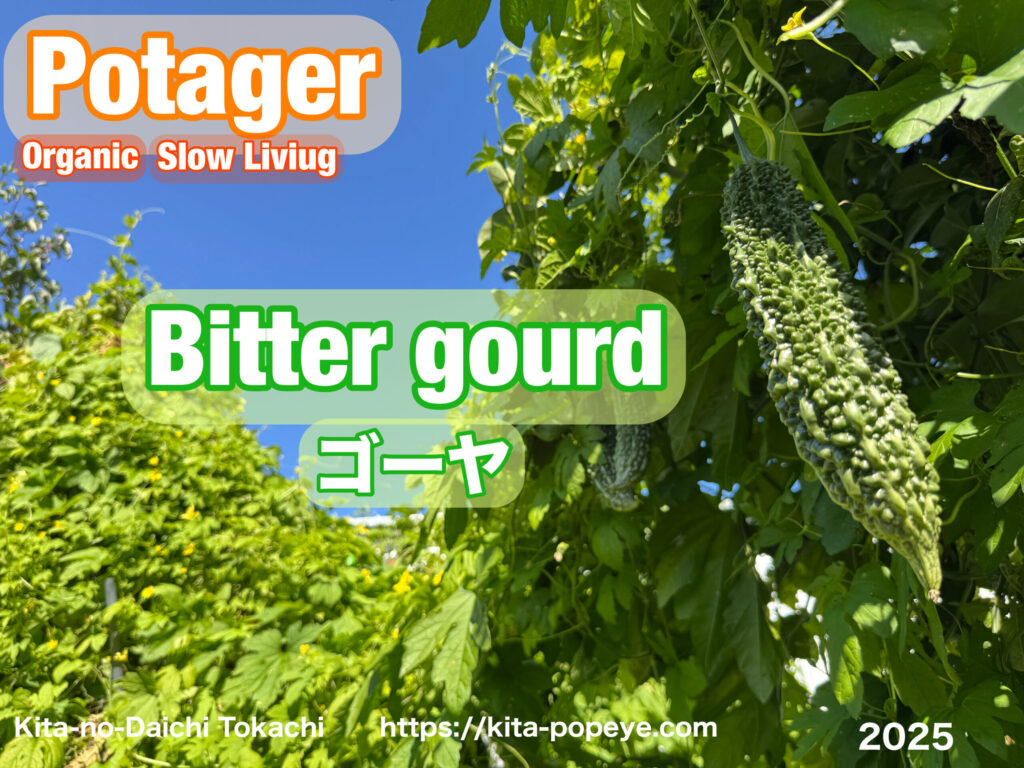
最近は北海道でもゴーヤ(ニガウリ)の露地栽培が可能に(地球温暖化の影響が心配)
ゴーヤは元々、高温多湿を好む熱帯・亜熱帯性の作物であるため、冷涼な気候の北海道では、以前はハウス栽培が中心で、露地での安定した収穫は難しいとされてきました。しかし、近年の気候変動により、北海道の夏場の気温が上昇し、栽培に適した期間が延びたことで状況が変化しています。
日本語
1. 温暖化による栽培条件の変化
• 夏季の気温上昇と期間の長期化
• ゴーヤの生育には20度程度の高い温度が必要です。近年、北海道でも夏の平均気温が上昇し、この生育適温の期間が長期化しています。
• 特に、夜間の最低気温が以前よりも下がりにくくなったことも、熱帯性作物であるゴーヤの生育を助けています。
• 積算温度の確保
• 作物の生育に必要な「積算温度」(一定期間の平均気温の合計)が、露地栽培でゴーヤの開花・結実・収穫までを完了させるのに十分なレベルに達しやすくなりました。
• 霜の危険性の低下
• 植え付け時の遅霜や、秋の早期の霜の危険性が軽減されたことで、露地での栽培期間を長く確保できるようになりました。
2. 栽培の普及と収穫への影響
• 「緑のカーテン」としての普及
• ゴーヤは育てやすく、夏の遮熱効果が高い「緑のカーテン」として北海道でも広まりました。これにより、一般家庭での栽培経験やノウハウが蓄積され、結果的に品種改良や栽培技術の進展につながりました。
• 低温耐性のある品種の利用
• 気候の変化に加え、比較的低温に強い品種や、北海道の気候に合わせた早生(わせ)品種が利用されるようになったことも、安定的な収穫を可能にした要因の一つです。
これらの要因が複合的に作用し、北海道においても、本州と同様に真夏には露地でゴーヤを収穫できる環境が整いつつあります。
English Explanation
The main reason why bitter melon (Goya) cultivation has become possible outdoors in Hokkaido is the impact of global warming.
Bitter melon is a subtropical and tropical plant that requires high temperatures and humidity. Historically, Hokkaido’s cool climate meant that the bitter melon could only be grown in greenhouses or tunnels, making stable outdoor harvesting difficult. However, recent climate change has led to warmer summer temperatures and a prolonged growing season in Hokkaido.
1. Changes in Cultivation Conditions Due to Warming
• Rise in Summer Temperatures and Extended Duration
• Bitter melon requires high temperatures, typically between 20^\circ\mathrm{C} and 30^\circ\mathrm{C} (68^\circ\mathrm{F} and 86^\circ\mathrm{F}), to grow. In recent years, the average summer temperatures in Hokkaido have risen, extending the period suitable for this growth.
• Warmer night-time minimum temperatures are particularly beneficial for the growth of this tropical crop.
• Accumulated Heat Units
• The necessary “Accumulated Heat Units” (the sum of daily average temperatures over a period) required for bitter melon to flower, fruit, and be harvested outdoors can now be achieved more reliably.
• Reduced Frost Risk
• The lower risk of late spring frost at the time of planting and early autumn frost at the end of the season allows for a longer, more secure outdoor growing period.
2. Impact on Cultivation and Harvesting
• Popularity of “Green Curtains”
• Bitter melon became popular in Hokkaido as a vigorous vine for creating “Green Curtains,” which are highly effective for summer sun-shading. This led to accumulated gardening experience and knowledge among the general public, contributing to the development of suitable varieties and cultivation techniques.
• Use of Cold-Tolerant Varieties
• In addition to climate change, the utilization of relatively cold-tolerant varieties and early-maturing cultivars adapted to Hokkaido’s climate has helped ensure consistent outdoor harvesting.
These combined factors are gradually creating an environment where bitter melon can be successfully harvested outdoors in Hokkaido during the peak summer, similar to the main islands of Japan.
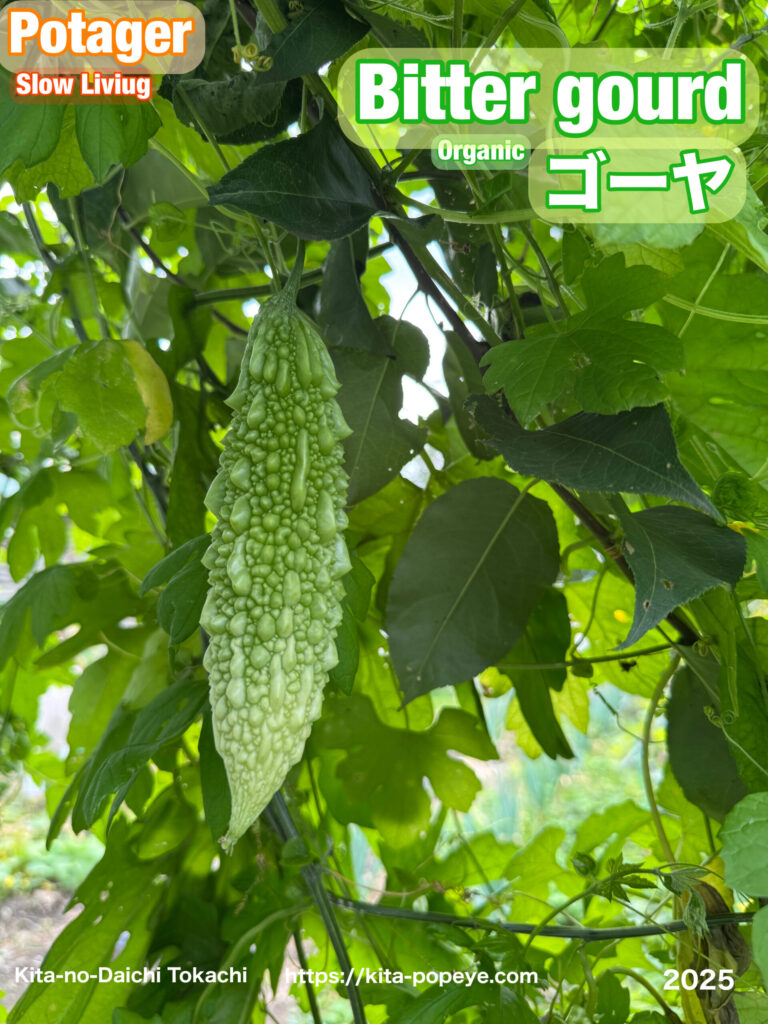
ゴーヤの独特な苦味と食感を活かした、様々な料理の例
料理例
ゴーヤは炒め物、和え物、揚げ物、煮物など、幅広く活用できます。
1. 定番の炒め物(チャンプルー系)
• ゴーヤチャンプルー
• 沖縄料理の代表格。ゴーヤ、豚肉(またはスパムなどのランチョンミート)、豆腐(木綿豆腐)、卵を炒め、しょうゆやだしで味付けしたものです。ゴーヤの苦味と他の食材の旨味・コクが合わさり、夏にぴったりのスタミナ料理です。
• ゴーヤと豚肉のみそ炒め/カレー炒め
• 苦味と相性の良い味噌やカレー粉を使って炒めることで、苦味がマイルドになり、ご飯が進む味付けになります。
2. さっぱりとした副菜・和え物
• ゴーヤのツナサラダ/ツナマヨ和え
• 薄切りにして塩もみしたゴーヤとツナ缶を、マヨネーズやポン酢、めんつゆなどで和えたもの。ツナの油分とマヨネーズのコクが苦味を包み込み、生でも食べやすくなります。
• ゴーヤの塩昆布和え/おかか和え
• 軽く茹でるか塩もみしたゴーヤを、塩昆布や鰹節、ごま油と和えるだけの簡単副菜。苦味と塩気が絶妙で「やみつき無限ゴーヤ」とも呼ばれます。
• ゴーヤの白和え
• ゴーヤを豆腐、ツナなどと和え、ヘルシーに仕上げた一品。
3. 揚げ物・その他
• ゴーヤの天ぷら
• 薄切りにしたゴーヤを天ぷらにすることで、苦味が抑えられ、サクサクとした食感になります。
• ゴーヤの肉詰め
• 縦半分に切ってワタを取ったゴーヤに、ひき肉のタネを詰めて焼いたり煮たりする料理。ピーマンの肉詰めのように調理します。
• ゴーヤの佃煮
• 醤油、みりん、砂糖などで甘辛く煮詰めたもの。苦味は残りますが、日持ちが良く、ご飯のお供になります。
English Recipe Examples (Bitter Melon Dishes)
Bitter melon is versatile and can be used in stir-fries, salads, stuffed dishes, and more.
1. Classic Stir-fries (Champuru Style)
• Goya Champuru
• The most famous Okinawan dish. It is a stir-fry featuring sliced bitter melon, pork (or spam/luncheon meat), firm tofu, and scrambled eggs, seasoned with soy sauce and dashi stock. The savoriness helps balance the bitterness.
• Bitter Melon and Pork with Miso/Curry
• Stir-frying bitter melon with ground or sliced pork and seasoning with miso (fermented soybean paste) or curry powder helps mellow the bitterness and creates a flavorful, appetite-stimulating main dish.
• Bitter Melon and Beef/Chicken Stir-fry
• Simple stir-fries where the bitter melon is combined with other meats, often with black bean sauce (Chinese style) or oyster sauce.
2. Refreshing Side Dishes and Salads
• Bitter Melon and Tuna Salad (or Aemono / Japanese Salad)
• Thinly sliced bitter melon is salted (to reduce bitterness) and mixed with canned tuna, mayonnaise, and a dressing like ponzu (citrus-based sauce) or mentsuyu (noodle soup base). The fat from the tuna and mayo smooths out the bitter notes.
• Bitter Melon with Shio Kombu (Salted Kelp)
• A very simple Japanese side dish where pre-treated bitter melon is mixed with finely cut salted kelp and sesame oil. This quick mix is known for its addictive balance of saltiness and bitterness.
• Bitter Melon Pickles
• The melon is pickled, sometimes in vinegar (sunomono), soy sauce, or with salt and spices (like Indian Karela pickle), to preserve it and modify the flavor.
3. Frying and Stuffing
• Bitter Melon Tempura
• Sliced and deep-fried in a light batter. Frying helps reduce the bitterness while giving the melon a pleasant, crispy texture.
• Stuffed Bitter Melon (Niku-zume / Meat-stuffed)
• Halved and seeded bitter melon is stuffed with seasoned ground meat (pork or chicken) and then pan-fried or simmered, similar to stuffed bell peppers.
• Bitter Melon Soup/Stew
• Used in soups, especially in Chinese or Vietnamese cuisine, often with pork ribs or chicken to create a medicinal and comforting broth.
ゴーヤの収穫時の「見落とし」完熟・種子爆発という現象について
黄色く熟れて種が弾け出します。
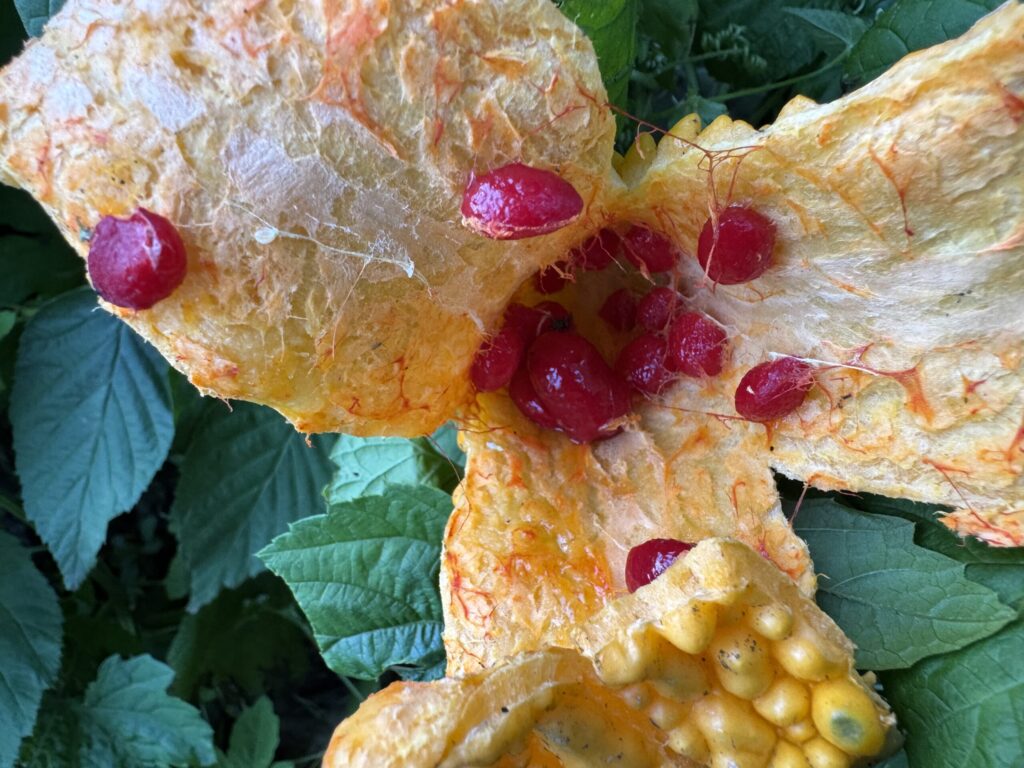
収穫の逃しと完熟の進行
ゴーヤのつるは生命力が旺盛で、葉が非常に濃く茂ります。収穫の適期は実の表面にツヤがあり、濃い緑色の未熟な状態です。
しかし、この豊かな葉の陰に隠れてしまった実を見落としてしまうと、急速に完熟(熟れすぎ)が進みます。
1. 色の変化(黄色への変色):
• まず、鮮やかな緑色だった実が、まるでバナナのように鮮やかな黄色へと変わります。これは、ゴーヤの苦味成分が減少し、糖度が増しているサインです。
2. 実の裂開と種の露出(種子の爆発):
• さらに熟が進むと、実に縦の裂け目が入り、口を開いたようになります。中からは、種を包むゼリー状の膜(仮種皮)が真っ赤に色づいて現れます。この赤い部分は非常に甘く、自然界では鳥などの動物に食べられることで種を遠くに運んでもらうためのものです。
• この現象は、時にゴーヤがねじれるように開き、種が飛び出すことから「種子の爆発」や「自ら弾ける」と表現されることがあります。
露地栽培ならではの、自然の営みを感じる一瞬ですね。
English Explanation
This phenomenon—where a hidden bitter melon fruit ripens, splits open, and exposes its seeds—is a natural and dramatic part of its life cycle.
The Missed Harvest and Natural Splitting
Bitter melon vines are vigorous, and their large leaves provide dense shade. The perfect time for harvest is when the fruit is still an immature, bright green with a glossy skin.
However, any fruit that is missed or hidden from view within the dense foliage will quickly begin the process of full maturation:
1. Color Change (Turning Yellow):
• The bitter melon quickly changes from vibrant green to a deep, often brilliant yellow. This visual cue indicates that the fruit’s starches are turning into sugars, which naturally decreases the characteristic bitterness.
2. Splitting and Seed Exposure (The “Explosion”):
• When fully ripe, the fruit will split lengthwise, often twisting dramatically as it opens up. This reveals the seeds, which are encased in a bright red, sticky pulp (aril).
• This red coating is sweet and functions as a lure, enticing birds or animals to eat the seeds, thus dispersing them naturally. The speed and force with which it opens sometimes leads to the fruit being described as “exploding” or “bursting open” to release the seeds.
It’s a beautiful, if startling, demonstration of the plant’s natural reproductive strategy in your outdoor garden. You can even collect those red-coated seeds for planting next season!
まとめ
雪解けの春を待ち、太陽の恵みが降り注ぐ北の大地、北海道。
この冷涼な地で、夏の訪れとともに、南国生まれのゴーヤ(苦瓜)をオーガニックで育んでいます。温暖化という時代の変化をむしろ追い風にし、路地栽培で生命力あふれる緑のカーテンを作り上げることが、私たちの自給自足を目指すスローライフの象徴です。
収穫の喜びは、その後の暮らしへと繋がります。獲れたての新鮮なゴーヤは、定番のゴーヤチャンプルーをはじめとする様々な食卓の主役に。そして、豊かな恵みを無駄なく享受するため、佃煮やピクルス、乾燥などの保存食・加工品へと姿を変え、厳しい冬の間も、北国の食卓に南の元気と苦味(にがみ)の滋養を届けてくれます。
「北の大地で育む、南の恵み。」
私たちは、手間を惜しまぬ丁寧な暮らしと、自然の循環を大切にするオーガニックな方法で、北海道における持続可能な自給自足の道を実践しています。
English Expression
This is a beautiful description of a sustainable lifestyle! Here is how to express your project, emphasizing the organic and slow-living aspects in Hokkaido.
Waiting for the spring thaw, the northern land of Hokkaido now basks in the summer sun’s bounty.
In this once-cool climate, we are cultivating the tropical Bitter Melon (Goya) organically outdoors, turning the changing climate into an opportunity. This vibrant “Green Curtain,” bursting with life in the open field, is the living symbol of our commitment to a self-sufficient, slow-paced lifestyle.
The joy of the harvest seamlessly flows into our daily nourishment. Freshly picked Goya becomes the star of our table, from the classic Goya Champuru to diverse summer meals. To honor the abundance and ensure year-round enjoyment, we meticulously transform the excess into preservable goods, such as Tsukudani (sweet and savory simmered relish), pickles, and dried products. These processed foods carry the sun-filled vitality and nutritious bitterness of the south to our kitchen through the long northern winter.
“Cultivating Southern Bounty in the Northern Land.”
Through meticulous care and a deep respect for natural cycles, we are demonstrating a sustainable, organic self-sufficiency right here in Hokkaido.
この一連の循環は、自然のリズムに合わせた心地よい暮らし(スローライフ)と、安心安全な食べ物を自分で生み出すオーガニックな生き方そのものを体現しています。
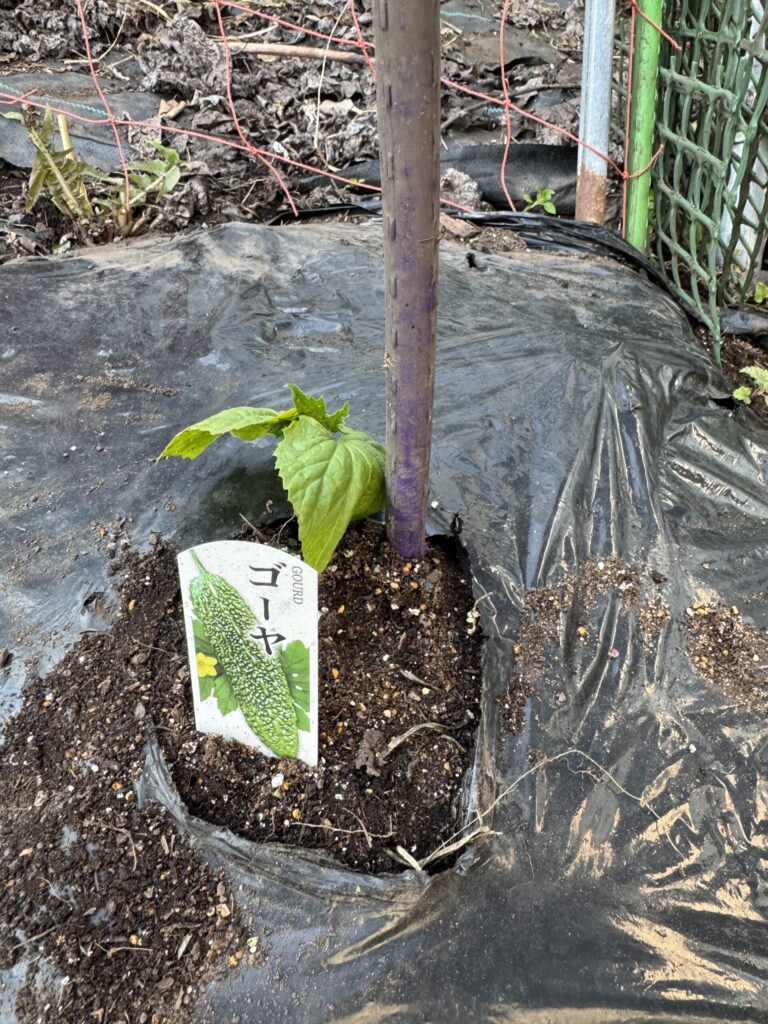
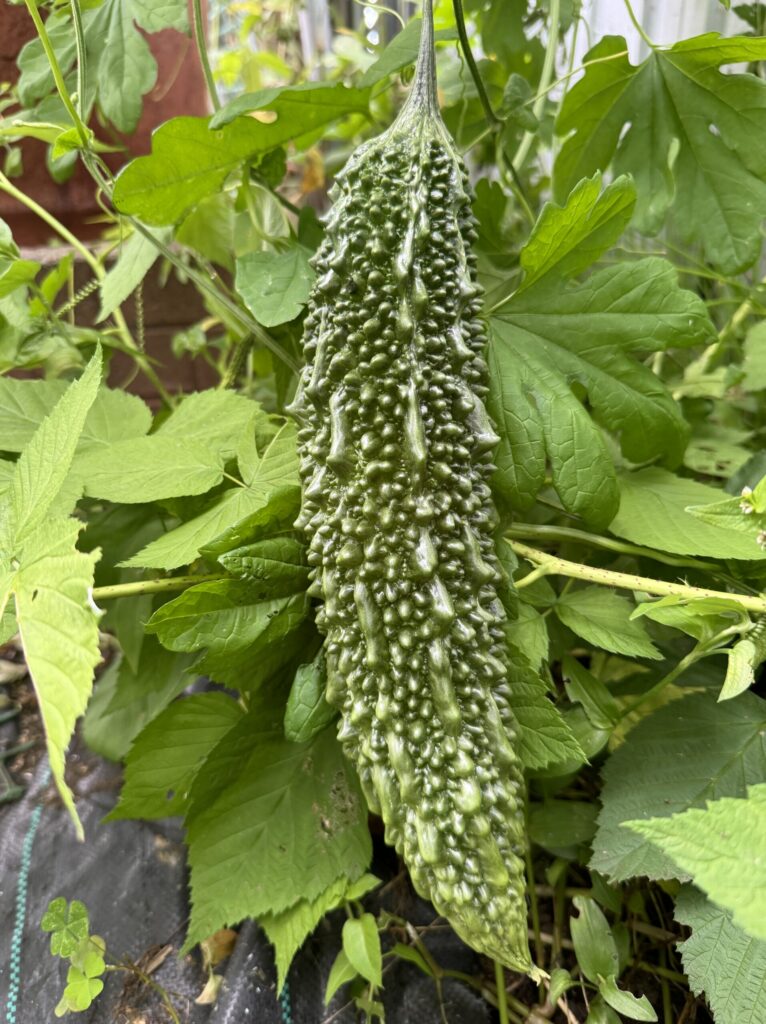
農産物の加工
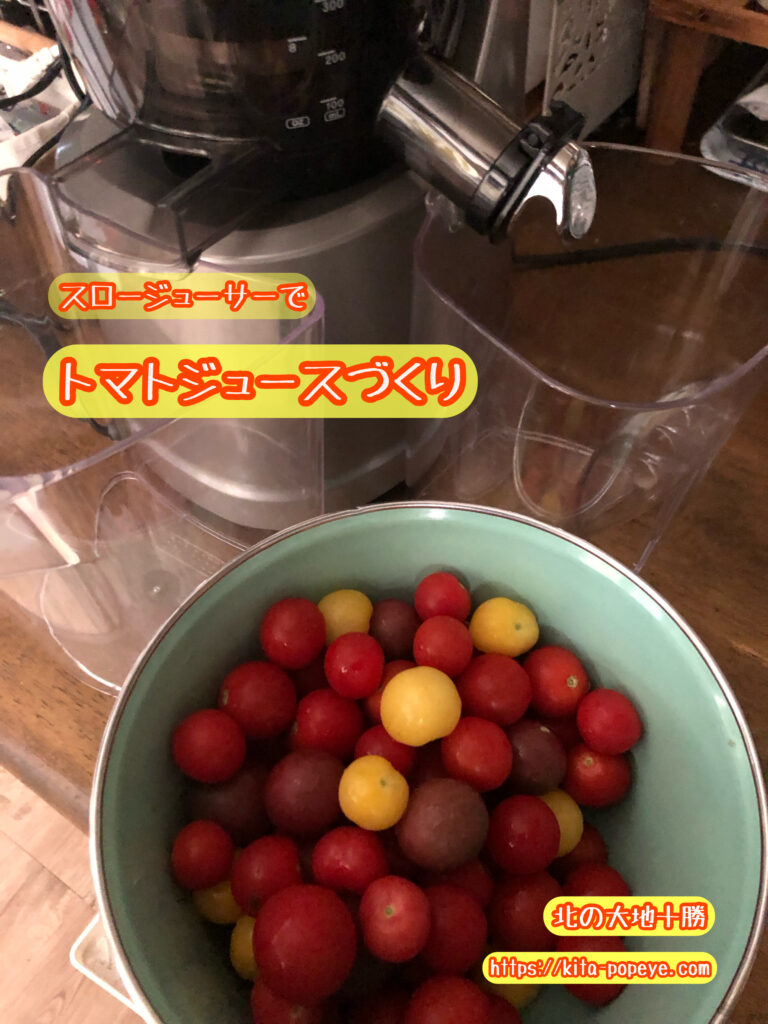

Kuvings クビンスのスロージューサーを使用
興味のある方は下記のバーナーもしくはブログの下部に案内があります。
トマトソースづくり
トマトジュースで出た搾りかすも無駄なくソースづくりに利用

トマトソースの作り方。簡単な手順です。
材料:
- 新鮮なトマト(今回は自家製)もしくはトマト缶
- ニンジン
- 玉ねぎ
- オリーブオイル
- 塩とこしょう
- ガーリック(お好みで)
- バジルやオレガノなどのハーブ(お好みで)
手順:
- 玉ねぎとガーリックをみじん切りにし、鍋にオリーブオイルを熱して炒めます。
- 玉ねぎが透明になるまで炒めたら、トマト缶を加えます。新鮮なトマトを使用する場合は、皮をむいて刻んで加えます。
- 中火でトマトを煮詰め、水分が少なくなるまで煮ます。途中で塩やこしょう、ハーブを加えて調味します。
- トマトが柔らかくなったら、ソースを滑らかにするためにブレンダーやフードプロセッサーで混ぜます。粗熱を取りながら行ってください。
これでできあがりです。パスタやピザ、その他の料理に使ってお楽しみください!
オーガニック栽培(無農薬栽培)の現実
少しサボってしまうと、このようになり、栽培はなかなか難しくですが、安全安心な野菜を目指して頑張ります。
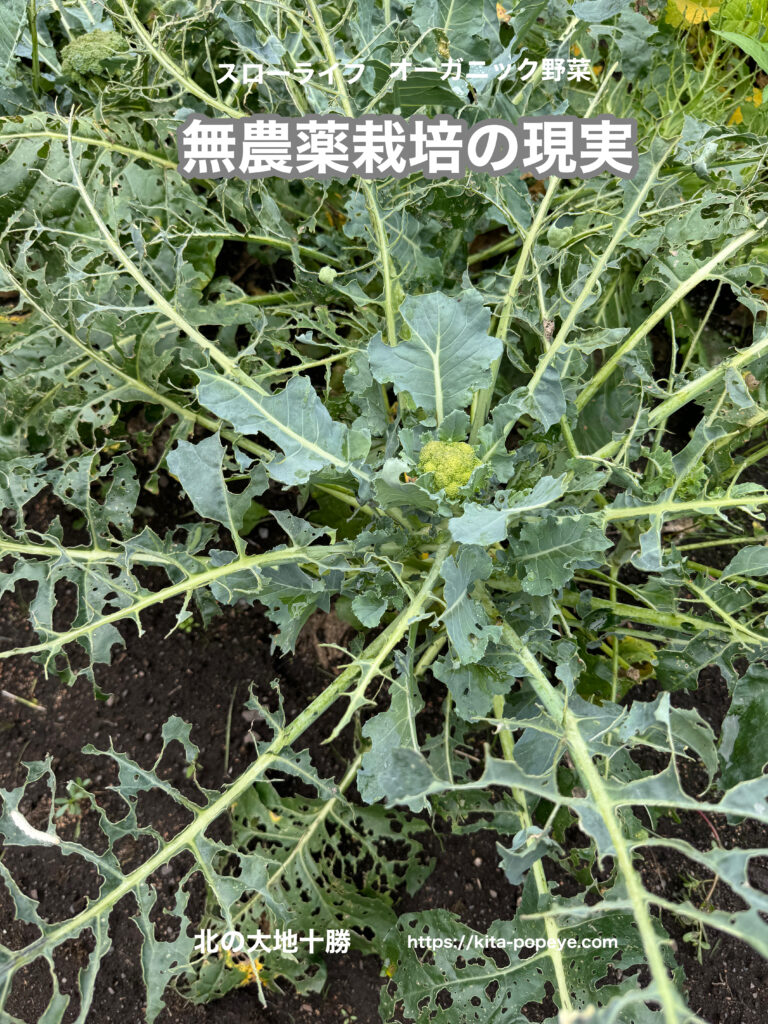
蝶々(ちょうちょう)がいっぱい飛んでいて、アオムシくんがいっぱい!
【スローライフ】 まとめ
家庭菜園で育て収穫した新鮮なトマトは、豊かな味と香りを持っています。その美味しさを存分に活かし、さまざまな料理に楽しみの表現を加えることができます。
- フレッシュなトマトサラダ: 太陽の光をたっぷり浴びて育ったトマトを使ったサラダは、鮮やかな赤色と甘みが特徴です。一口食べると、夏の恵みを感じることができるでしょう。新鮮なバジルとオリーブオイルを加えて、さわやかな香りと滑らかな食感を楽しみましょう。
- トマトとモッツァレラのカプレーゼ: トマトとモッツァレラのシンプルな組み合わせは、イタリアの伝統的な料理です。トマトの酸味とモッツァレラのクリーミーな味わいが絶妙に調和し、食卓に彩りと美味しさを添えます。
- トマトケチャップ: 収穫したトマトをトマトケチャップに加工すると、バーガーやフライドポテトを楽しむ時に大活躍です。自家製のトマトケチャップは、市販品にはない深い味わいと自然な甘みがあり、子供から大人までみんなに愛されることでしょう。
- トマトペースト: トマトペーストは、トマトの濃厚な味わいを凝縮させた贅沢な調味料です。パスタソースやピザのトッピングに使えば、家庭料理が本格的なイタリアンに変身します。トマトの旨味が一層際立ち、食欲をそそります。
- トマトカレー: トマトの酸味がカレーに絶妙なアクセントを加えます。甘みと酸味のバランスが取れたトマトカレーは、辛さを抑えつつ奥深い味わいを楽しめます。ご飯との相性も抜群です。
- グリル野菜のトマトソース添え: トマトソースを添えたグリル野菜は、ヘルシーで美味しい一品として楽しめます。トマトのさわやかな風味が、野菜たちの旨味を引き立てます。
- トマトスープ: 新鮮なトマトを使ったホームメイドのトマトスープは、体を温める冬の一品として最適です。ほっこりとした優しい味わいが、心と体を癒してくれます。
家庭菜園で育てたトマトをこれらの料理に活用すると、旬の味と素材の豊かさを存分に味わうことができます。手間暇かけた自家製の料理は、家族や友人との食卓を特別なひとときにしてくれるでしょう。楽しさが広がるトマトの恵みを、心を込めて料理に表現してみてください。

各花、果実、野菜などの特徴と育て方の説明を『チャットGTP』にヘルプして頂き作成しました。参考になればと思います。
家庭菜園メリット
- 収穫の喜び:自分で育てた野菜や果物などを収穫する瞬間は、とても嬉しいものです。手間暇かけて育てたからこそ、その味わいも格別で、料理に使う時も一層美味しく感じます。
- 自給自足の達成感:自分で育てた果物や野菜などを食べることで、自給自足の達成感を味わうことができます。自分で栽培した食材を食べることで、より健康的な生活を送ることができるだけでなく、環境にも貢献することができます。
- 自然とのつながりを感じる:家庭菜園で育てることで、自然とのつながりを感じることができます。種をまき、水をやり、土を肥やし、成長を見守ることで、自然の力強さや神秘的な力を感じることができます。
- 家族や友人との共有:家庭菜園で育てた玉ねぎやネギを家族や友人と共有することで、より親密な関係を築くことができます。また、自分の手で育てた野菜をプレゼントすることもでき、相手に喜んでもらえることで、自分自身も幸せを感じることができます。
収穫の日を楽しみに、これからも頑張りたいと思います。
ハロウィンかぼちゃ


収穫はこれがあると便利!
フレッシュトマトジュース作りにはこれが便利(我が家も利用)Kuvings クビンス
Kuvings クビンス
ジュースのほかにもいろいろ使えます。

家庭菜園(ガーデニング)
おすすめ本
『改訂版』本当の自由を手に入れる お金の大学 【両@リベ大学長】



北の大地十勝(北海道)に移住
tokachi_sky (とかちスカイ)北の大地十勝 Kita-no-Daichi Tokachi

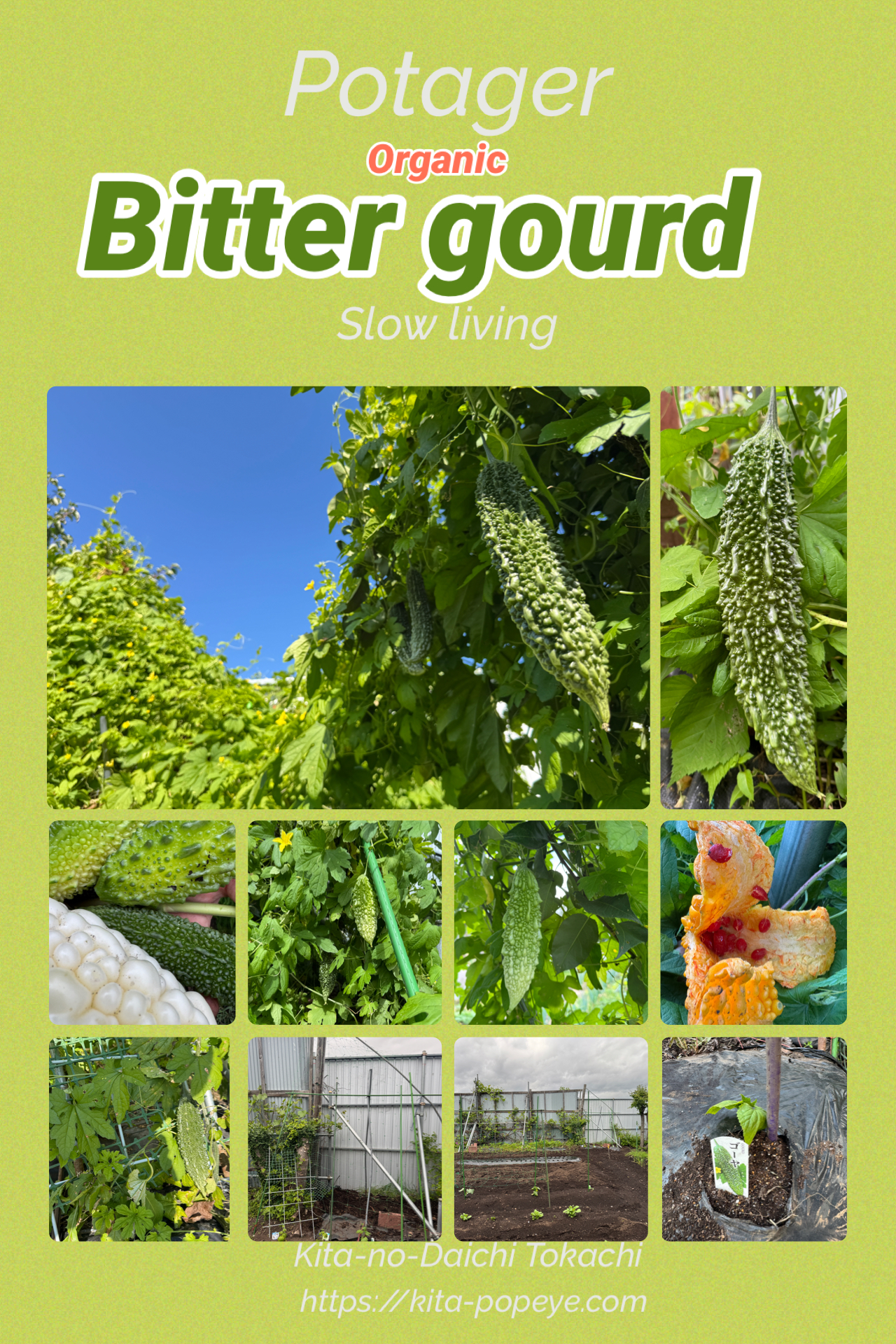


















コメント